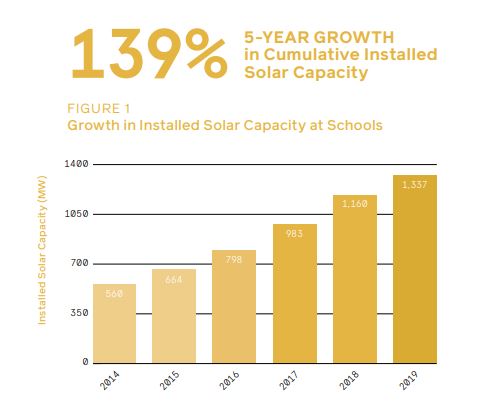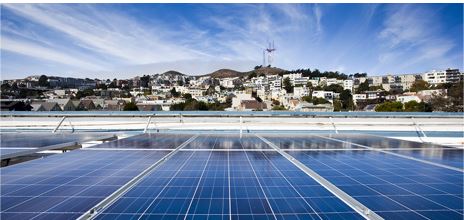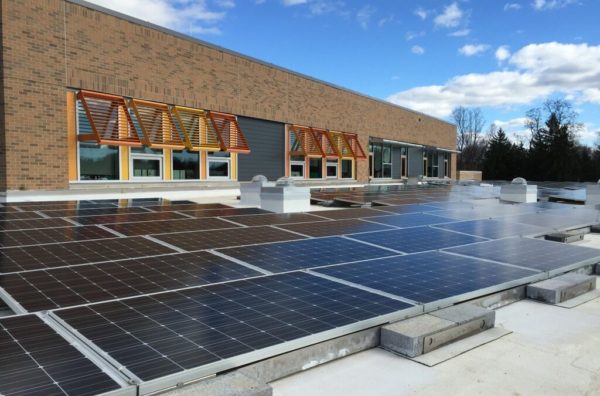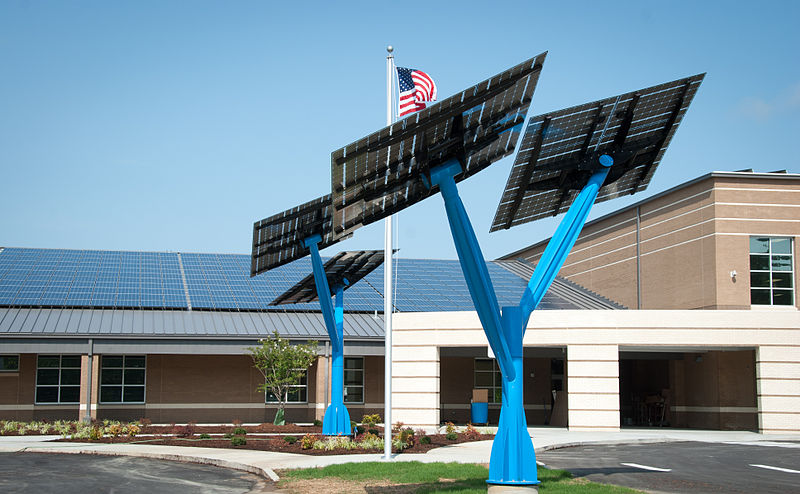When thinking of how to improve schools, the first thoughts often turn to newer books, better-paid teachers, and an improved curriculum.
Energy is second only to teacher salaries when it comes to cost, according to NREL, and U.S. schools spend more than $6 billion a year on the line item. Solar presents an opportunity for schools to alleviate budget pressure, often at little or no upfront cost, freeing up funds for more educational benefits.
Schools often sign a power purchase agreement (PPA) when going solar, allowing the school to buy the electricity produced by the solar installation for 10-25 years at a discounted rate, serving up cost savings from day one. About 90% of installed school systems since 2014 have entered the PPA model, and the little-no-upfront cost or ongoing maintenance costs make it a nimble operation for tight-budgeted schools, according to SEIA.
 The deployment of solar on schools has grown in recent years, but many schools have not taken that step. The Solar Energy Industries Association (SEIA) reports that through 2019, some 7,332 solar schools were equipped across the U.S., representing 5.5% of K-12 institutions.
The deployment of solar on schools has grown in recent years, but many schools have not taken that step. The Solar Energy Industries Association (SEIA) reports that through 2019, some 7,332 solar schools were equipped across the U.S., representing 5.5% of K-12 institutions.
Average system size for these schools was 182 kW, and over 1.3 GW had been activated. Roughly 9.4% of all students attend a solar school, according to the SEIA report. The “valedictorian” state was California, with one-third of the nation’s solar schools and 45% of the total installed capacity, at 616 MW.
Between 2014 and 2019, SEIA reported a 139% growth in cumulative installed capacity. In that five-year span, schools accounted for roughly 8-10% of cumulative installed capacity of nonresidential projects.
While growth has been strong, one group, Generation180, thinks the U.S. can do better. The group is dedicated to helping boost the attach rate, and provides resources to help guide decision makers at schools navigate the solar process and understand the benefits.
How-to
Generation180 runs a national campaign for solar advocacy, and offers a toolkit as a step-by-step grassroots organizing guide. Once the school district has buy-in from the community, decision makers can use Generation180’s how-to guide for going solar.
In the guide, eight steps are laid out for getting started:
- Assemble a team: include teachers, students, staff from facilities and procurement, and consider help from outside experts.
- Understand energy needs and estimate solar potential: review electricity use history, estimate costs and potential savings, assess site potential and solar output potential.
- Compare financing options: assess ownership options including direct or PPA, and investigate local, state, federal and utility incentives.
- Identify regulatory hurdles: learn local planning and zoning requirements, investigate net metering opportunities.
- Prepare and issue a request for proposal: ensure RFP meets statutory requirements, clearly define the project, and include educational opportunities.
- Evaluate and select the developer: develop a list of key criteria and a scoring plan.
- Oversee construction and installation: hold regular progress monitoring meetings, document regulatory compliance, and perform regular inspections.
- Monitor performance, operations, maintenance: if necessary, develop an operations and maintenance agreement, and ensure ongoing safety of the site.
Success stories
Some schools have undergone this process and offer an example for other districts to learn from.

Image: Generation180
For example, the San Francisco Unified School District (SSFUSD) includes 136 schools and 55,000 students. In 2017, the school district adopted a carbon-neutral resolution that called for phasing out fossil fuels by 2040 and generating all power on-site by 2050. The district installed its first solar projects 10 years ago, and over the past decade has saved more than $20 million on energy bills.
Developed in partnership with ENGIE, SSFUSD has installed over 2 MW of PV capacity, implemented high energy-efficiency technologies, and has reduced its energy expenditures by over 75%. The solar was installed in two main phases, with 1.68 MW added in phase one on fifteen school locations. Phase two added three more sites, totaling 352 MW. The installations were mounted on carports, athletic stadiums, and academic buildings.
Another example is the Discovery Elementary School in Arlington, Virginia. Opened in 2015, it became one of the largest buildings in the country to be certified as zero energy. The building was designed to be 66% more energy efficient than the district average by optimizing solar orientation and shading, in addition to installing smart energy efficiency upgrades on heating and cooling, lighting, and more.

Image: NREL
The 496 kW, 1,700 panel system produces more energy than the school uses, and it saves roughly $100,000 a year in energy costs. It sits upon single-axis trackers to maximize output. In planning for construction of the school, it was discovered the building would cost $262 per square foot without solar, and $316 per square foot with it.
While solar made a sizeable impact on the building’s construction costs, it helped the school achieve net zero, and it is expected to produce a net financial benefit in energy bill savings. Plus, with solar falling steadily in cost since the school’s construction in 2015, and more incentives coming online across the country in that time, the cost-effectiveness of solar on schools has only improved.
This content is protected by copyright and may not be reused. If you want to cooperate with us and would like to reuse some of our content, please contact: editors@pv-magazine.com.









Don’t forget to factor in EV school buses. Free ‘fuel’ from the panels and a dual-use option with the stored power.
With V2G, schools+EV buses could become virtual power stations–particularly during weekends, summer months, holidays, natural disasters, etc.